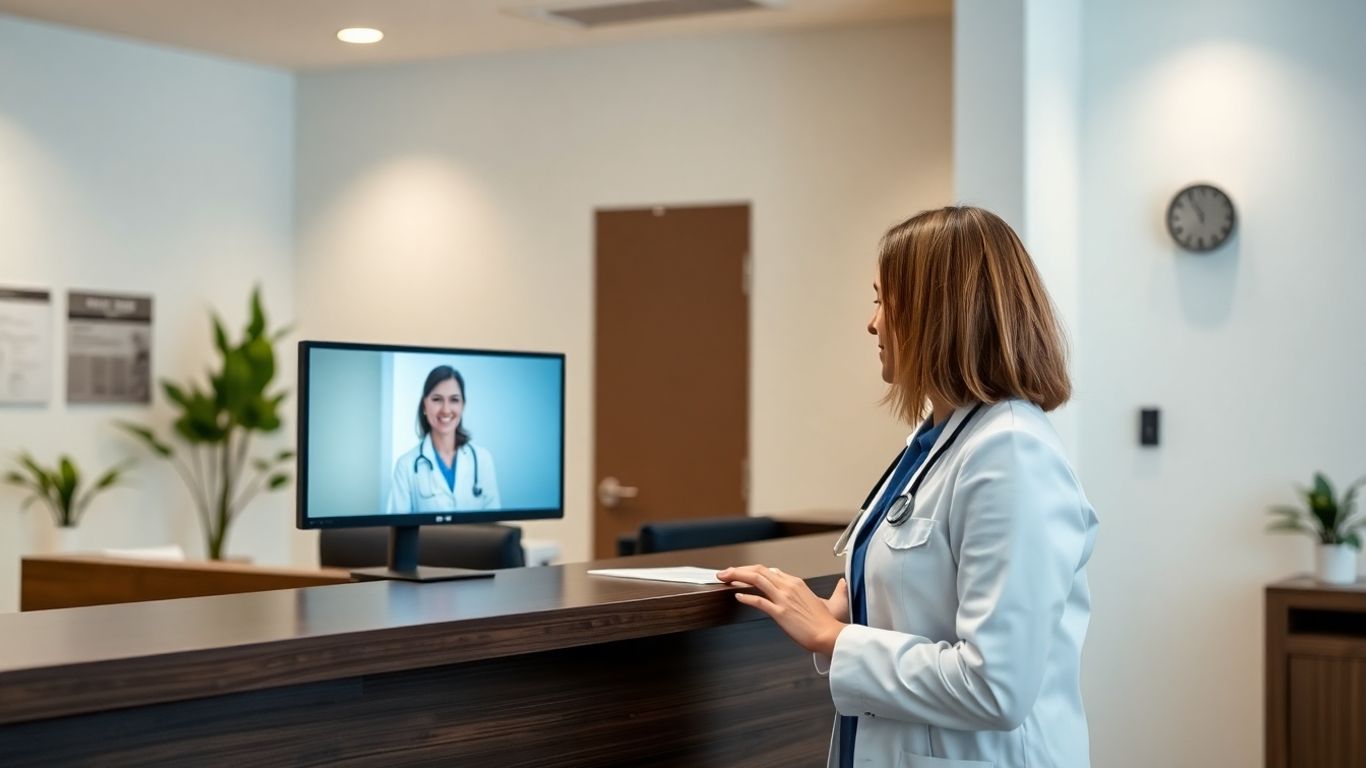Running a medical practice these days is a lot. You've got patient care, sure, but then there's all the paperwork, scheduling headaches, and endless phone calls. It feels like there's never enough time in the day to get it all done, right? Well, what if I told you there's a way to get some of that time back and make things run smoother? We're talking about virtual medical receptionist services. Think of it as having an extra pair of hands, but they work remotely and handle a bunch of those annoying administrative tasks so you and your team can focus on what really matters: your patients.
Think of a medical receptionist as the friendly face and organized brain of a doctor's office. They're the first person you talk to, the one who juggles appointments, answers your questions, and keeps everything running smoothly. Traditionally, this role was always in-person, right there at the front desk. But things are changing, and fast.
A virtual medical receptionist service is basically an off-site extension of your practice's front desk. These professionals handle many of the same tasks as their in-office counterparts, but they do it remotely. They use secure communication systems and specialized healthcare technology to manage calls, schedule appointments, handle patient inquiries, and more. It’s like having a dedicated administrative assistant who isn't physically in your office.
For years, the front desk was a physical space, a hub of activity. But with advancements in technology and a growing need for flexibility, practices are looking beyond the traditional setup. Staffing shortages and the desire to cut down on overhead costs have pushed many to explore virtual solutions. This shift isn't just about saving money; it's about adapting to how people work and how patients expect to interact with healthcare providers today. It’s a move from a fixed location to a more fluid, tech-enabled approach.
So, what exactly do these virtual pros do? A lot, actually. They're not just answering phones; they're integral to the patient experience and practice operations. Here's a breakdown of common duties:
The core idea is to replicate the essential functions of an in-office receptionist, but with the added benefits of remote work, such as increased flexibility and potential cost savings. This allows the practice's on-site staff to focus on more complex patient interactions and clinical duties.
When patients first connect with your practice, that initial interaction sets the stage for everything that follows. A friendly voice, quick answers, and easy appointment booking make a big difference. Virtual receptionists are really good at this. They're trained to be helpful and professional, making sure every patient feels heard and valued right from the start.
Think about it: how many times have you called a doctor's office and been put on hold forever, or worse, the call just went to voicemail? It's frustrating. Virtual receptionists change that. They're available to answer calls and messages promptly, often outside of traditional office hours. This means patients can get the information they need or book appointments when it's convenient for them, not just when your office is open.
Patients today expect immediate attention. A virtual receptionist ensures that your practice is always accessible, providing a consistent point of contact that builds patient loyalty and satisfaction.
Booking appointments can be a hassle, both for patients and your staff. Virtual receptionists can manage your schedule efficiently. They can handle online bookings, confirm appointments, and send out reminders. This not only makes it easier for patients to manage their visits but also significantly cuts down on no-shows, which helps keep your clinic running smoothly.
Here's how it works:
Every interaction a patient has with your practice contributes to their overall perception. A virtual receptionist acts as a professional extension of your team. They communicate clearly, answer questions accurately, and handle sensitive information with care. This consistent, high-quality communication builds confidence and trust, making patients feel more secure and well-cared for throughout their healthcare journey.
Let's be real, running a medical practice isn't cheap. You've got salaries, benefits, rent, equipment – the list goes on. Bringing in a virtual medical receptionist service can seriously cut down on those overhead costs. Think about it: no need for extra office space, fewer supplies, and you're not paying for benefits for a full-time, in-house receptionist. It's a smart way to manage your budget without sacrificing quality. Plus, these services often work with you to figure out the best plan, so you're not paying for more than you need.
What happens when your practice gets busier? Or when you want to open another location? Hiring and training new front-desk staff for every new spot can be a headache. Virtual receptionists offer a much simpler solution. You can easily scale up or down the support you need, whether it's handling more calls during flu season or managing appointments for a new satellite office. This flexibility means you're always covered, without the usual hiring and onboarding drama.
Worried about a new system messing up your current workflow? Most virtual receptionist services are built to play nice with the technology you already use. They can connect with your electronic health record (EHR) system, your appointment scheduling software, and other practice management tools. This means less manual data entry, fewer mistakes, and a smoother flow of information all around. It's about making your existing setup work even better, not replacing it entirely.
The real win here is freeing up your team's time. When administrative tasks are handled efficiently by a virtual service, your doctors and nurses can spend more time with patients, and your in-office staff can focus on providing great service to those who are physically present. It creates a more focused and less stressed environment for everyone.
Here's a quick look at how costs can compare:
Think about your clinic's day-to-day. How much time do your doctors and nurses spend on things that aren't directly patient care? Things like scheduling, answering basic questions, or sorting through paperwork. It adds up, right? Delegating these tasks to a virtual receptionist service can really free up your team.
Doctors and nurses are highly trained professionals. Their time is best spent diagnosing, treating, and connecting with patients. When they're bogged down with administrative duties, it takes away from that. A virtual receptionist can handle a lot of that noise. They can manage appointment bookings, send out reminders, and even do initial patient intake over the phone or through secure messaging. This means your clinicians can focus more on what they do best – healing people. It's not just about making their jobs easier; it's about making their work more impactful.
Your front-office staff are the gatekeepers of your practice. They're often juggling phone calls, greeting patients, and managing walk-ins. When the phone rings constantly or a patient has a complex scheduling request, it can really disrupt their workflow. Virtual receptionists can act as a buffer. They can handle routine calls, answer frequently asked questions, and manage appointment changes, allowing your in-house team to concentrate on the patients who are physically present or require more immediate attention. This leads to a smoother operation overall.
Let's be honest, healthcare can be demanding. Long hours and high stress are common. By offloading some of the repetitive administrative tasks, you can help reduce the overall workload for your staff. This can lead to less burnout and a better work-life balance. When staff feel less overwhelmed and more focused on meaningful tasks, they tend to be happier and more engaged. It's a win-win: your staff feel more supported, and your practice benefits from a more energized and productive team.
Delegating administrative tasks isn't about replacing staff; it's about reallocating valuable human resources to where they have the most impact. It allows skilled professionals to concentrate on patient care and complex problem-solving, rather than getting caught up in routine operational duties that can be effectively managed by a dedicated virtual service.

The way we interact with healthcare is changing, and the front desk is right in the middle of it. We're seeing a big shift from the traditional, in-person receptionist to models that blend human staff with technology. This isn't just about being modern; it's about meeting patients where they are and making healthcare more accessible.
Telehealth has exploded, and virtual receptionists are key to making it work smoothly. They handle the scheduling for virtual appointments, send out reminders, and manage follow-ups, just like they would for in-person visits. This means patients can connect with their doctors from anywhere, and the administrative side of things keeps running without a hitch. It’s about making sure that even when care is remote, the patient experience is still top-notch and organized.
Artificial intelligence is really starting to play a bigger part. Think about AI-powered chatbots that can answer common questions instantly, or systems that can help sort and route patient inquiries more efficiently. These tools aren't meant to replace human interaction entirely, but to handle the routine stuff so that human staff can focus on more complex or sensitive patient needs. AI can process information and respond much faster than a human, which is a game-changer for reducing wait times.
Looking ahead, we can expect even more integration. We might see virtual receptionists that can proactively reach out to patients based on their health data, or systems that offer even more personalized communication. The goal is to create a healthcare experience that's not only efficient but also feels more connected and supportive for every patient. It's a move towards a more proactive and patient-centered approach to healthcare administration.

So, you're thinking about bringing a virtual medical receptionist into your practice. That's a big step, and like any change, it needs some thought. It's not just about signing up for a service; it's about making sure it fits your clinic and your patients.
Before you even look at providers, take a good, hard look at what your practice actually needs. What are the biggest headaches your current front desk deals with? Are calls constantly getting dropped? Is appointment scheduling a tangled mess? Maybe your staff is swamped with basic questions that could be handled elsewhere. Jotting down these pain points is your first step. Think about the volume of calls, the types of inquiries you get, and how much time your staff spends on administrative tasks versus patient care. This will help you figure out what features are non-negotiable and what's just a nice-to-have.
Here's a quick way to think about it:
It's easy to get caught up in the shiny new tech, but the most important thing is that the service actually solves problems for your practice and makes things better for your patients. If it doesn't, it's just another expense.
Once you've picked a service, the actual switch needs to be planned. It's not usually a flip-of-a-switch kind of deal. You'll want to phase things in if possible. Start by having the virtual receptionist handle just one or two tasks, like appointment reminders or answering basic FAQs. See how that goes. Then, gradually add more responsibilities as you and your team get comfortable.
Here’s a general roadmap:
Your existing team is key to making this work. They need to understand that the virtual receptionist isn't there to replace them, but to help them. They need to know how to hand off calls, how to access information the virtual receptionist has gathered, and how to manage any new software or communication platforms involved. Think of it as giving your team a new, very capable assistant. Make sure they feel supported and understand the 'why' behind the change. Regular check-ins and open communication channels will help everyone adapt and get the most out of the new setup.
When you bring a virtual medical receptionist service into your practice, you're not just looking for convenience; you're also thinking about how to keep things safe and by the book. Patient information is super sensitive, and protecting it is a big deal. It's not something to mess around with.
Think about all the personal health details that get shared over the phone or through messages. A virtual receptionist service needs to have strong security measures in place. This means using encrypted communication tools so that conversations can't be easily intercepted. They should also be using secure networks and software that's built with privacy in mind. It's like putting a good lock on your digital door.
It's important to remember that the virtual receptionist is an extension of your practice. Any security lapse on their end can reflect directly on your clinic's reputation and legal standing. Due diligence in selecting a provider is key.
Just like you'd want to know your doctor is qualified, you need to be sure your virtual receptionist team is too. This isn't just about general customer service skills; it's about understanding the medical field and its rules. Ask about their training and any certifications they hold. Some services might have staff with medical administrative certifications, which is a good sign they know what they're doing.
This is a big one for any healthcare provider. The Health Insurance Portability and Accountability Act (HIPAA) sets the rules for protecting patient health information. Any virtual receptionist service you work with absolutely must be HIPAA compliant. This means they have to follow specific rules about how they store, transmit, and handle Protected Health Information (PHI). They should be able to explain their compliance measures clearly. It's not just a suggestion; it's a legal requirement that protects both your patients and your practice from serious penalties.

So, who really benefits from bringing a virtual medical receptionist into their practice? It turns out, a lot of different types of healthcare providers can find serious advantages. It's not just for one kind of clinic anymore.
For those running a small clinic or working as a solo practitioner, every dollar and every minute counts. Hiring a full-time, in-house receptionist can be a huge expense, not to mention the hassle of finding space and managing another employee. This is where virtual receptionists really shine. They handle all the front-desk stuff – answering calls, booking appointments, taking messages – without you needing to worry about office space or benefits. It's a way to get professional support without the big overhead. Think of it as having a dedicated assistant who's always there, but without the physical presence. This kind of support can make a big difference in how smoothly your practice runs day-to-day. You can even get help with tasks like appointment scheduling and patient inquiries.
If your practice is all about telehealth or you're part of a virtual care team, a virtual receptionist is a natural fit. They're already working in a digital space, so integrating them into your telehealth workflow is pretty straightforward. They can manage the scheduling for virtual appointments, send out reminders, and handle patient communications before and after their online visits. This keeps things organized and makes the whole virtual care experience feel more polished and patient-friendly. It’s about making sure the digital front door is just as welcoming and efficient as a physical one.
Doctors and specialists often have packed schedules, with patient appointments, surgeries, and consultations taking up most of their day. The administrative tasks that pile up – returning calls, managing appointment changes, answering billing questions – can eat into valuable time that should be spent with patients. A virtual medical receptionist can take a significant chunk of this off their plate. They act as a buffer, handling routine inquiries and administrative duties, allowing doctors to focus on what they do best: providing medical care. It’s about giving them back time and reducing distractions.
New healthcare startups or practices that are expanding to multiple locations face unique challenges. They need a consistent, professional front-office presence across all sites, but managing multiple physical reception desks can be complicated and expensive. Virtual receptionists offer a scalable solution. They can provide centralized support that grows with the practice, ensuring a uniform patient experience no matter which location a patient interacts with. This flexibility is key when you're trying to build and expand your healthcare service.
The administrative load in healthcare is immense, often pulling clinicians away from direct patient care. Virtual receptionists are not just about answering phones; they are a strategic tool to reclaim valuable time and streamline operations, allowing medical professionals to concentrate on healing and patient well-being.

Let's face it, communication in a busy medical practice can feel like a tangled mess sometimes. Phones ringing off the hook, messages piling up, and trying to get the right information to the right person can be a real headache. But what if technology could untangle that knot for you? That's where virtual receptionist services really shine, using smart tools to make things flow much smoother.
Remember those endless forms patients used to fill out in the waiting room? Or the lengthy phone calls just to get basic contact and insurance details? Virtual receptionist services can take that burden away. They use secure online forms and automated systems to collect patient information before their appointment. This means less time spent by your staff on data entry and more time for actual patient care. Plus, it gives patients a convenient way to provide their info on their own schedule.
The goal here isn't just to be fancy with tech; it's about making the whole process simpler for everyone involved. When patient data is collected efficiently and accurately upfront, it sets a positive tone for their entire visit.
Think of AI chatbots and voice assistants as your always-on front-desk helpers. They can handle a surprising number of tasks. Need to book a routine check-up? Ask the chatbot. Wondering about office hours? The voice assistant has the answer. These tools can answer frequently asked questions, guide patients to the right department, and even help schedule appointments without human intervention. This frees up your human staff to deal with more complex or sensitive patient needs.
How much time does your team spend answering the same questions over and over? "What's your address?" "Do you take my insurance?" "Can I reschedule my appointment?" Virtual receptionist technology can automate responses to these common queries. More advanced systems can even analyze the patient's request and route them to the most appropriate person or department automatically. This means fewer dropped calls, faster resolution for patients, and less interruption for your clinical staff. It's about making sure the right information gets to the right place, quickly and without fuss.
When patients call a medical office, they're often dealing with something stressful, whether it's a new symptom or a follow-up appointment. The last thing they need is to feel ignored or frustrated by the front desk. This is where virtual receptionists really shine, making a big difference in how patients feel about their care.
Think about it: nobody likes being put on hold, especially when they're worried about their health. Traditional offices can get swamped, leading to long waits on the phone or calls that just go unanswered. Virtual receptionists, however, are trained to handle calls efficiently. They're not juggling a dozen other tasks like an in-house receptionist might be. This means quicker answers and fewer dropped calls. This consistent availability makes patients feel heard and valued from the very first interaction.
Healthcare is for everyone, and that means communication needs to be clear for all patients, regardless of the language they speak. Many virtual receptionist services can provide staff who are fluent in multiple languages. This is a huge plus for diverse communities. When patients can speak comfortably in their native tongue, it builds trust and makes them feel more at ease. It shows the practice cares about accessibility for everyone.
It might seem counterintuitive, but virtual receptionists can actually make interactions feel more personal. Because they're focused solely on communication, they can dedicate their full attention to each caller. They can access patient information quickly, answer questions thoroughly, and even manage appointment scheduling with a friendly, professional tone. This dedicated focus can lead to a smoother, more positive experience, making patients feel like they're getting individual attention rather than being just another number.
When patients can easily reach someone to help them, they feel much happier. Our virtual receptionists make sure every caller gets the attention they need, leading to better patient experiences. Want to see how this can boost your practice? Visit our website to learn more!
So, we've talked a lot about how virtual receptionists can really change things for a medical practice. It's not just about saving a few bucks, though that's a nice bonus. It's about giving your staff more time to actually focus on patients, making sure no one feels like they're stuck on hold forever, and just generally running a smoother operation. Think of it as getting a helpful assistant who's always there, ready to handle the routine stuff so you and your team can concentrate on what you do best. If you're looking to make your practice run a bit better and keep your patients happier, looking into virtual receptionist services is definitely worth your time.
Think of a virtual medical receptionist as a super helpful assistant who works remotely. Instead of being in your office, they use technology like phones and computers to do all the important front desk jobs. This includes answering calls, setting up appointments, and helping patients with their questions, just like a receptionist in person would.
The main difference is where they work! A regular receptionist is right there in your office. A virtual one works from their own location. They use special tools and software to do the same tasks, like managing schedules and talking to patients, but from afar. It's like having an assistant who's always available, even if they're not physically present.
Yes, they can handle most of the common tasks. This includes answering phones, scheduling and reminding patients about appointments, taking messages, and even helping with basic insurance questions. They are trained to be professional and helpful, making sure patients feel well taken care of.
Absolutely. Virtual medical receptionist services use very secure technology. They follow strict rules, like HIPAA, to make sure all patient information is kept private and safe. It's just as secure as if they were working right there in your office.
Yes, it often does! Hiring a virtual receptionist can cost less than hiring someone full-time in your office. You save on things like office space, equipment, and sometimes even benefits. It's a more affordable way to get professional front desk help.
It helps a lot! By taking care of the phone calls and scheduling, virtual receptionists free up your doctors and nurses. This means your staff can spend more time focusing on patients and less time on office chores. It makes their workday smoother and less stressful.
That's one of the best parts! Virtual receptionist services are very flexible. They can easily handle more calls and tasks when you're busy and less when things are quiet. This means you always have the right amount of support, no matter how busy your practice gets.
Getting started is usually quite simple. You'll work with the service provider to set things up, tell them about your practice, and connect them to your systems. They often provide training for your staff too, making the switch smooth and easy.
Start your free trial for My AI Front Desk today, it takes minutes to setup!








